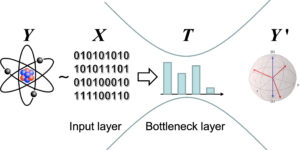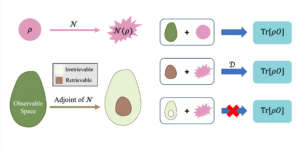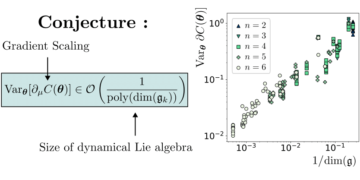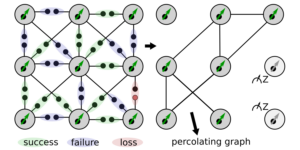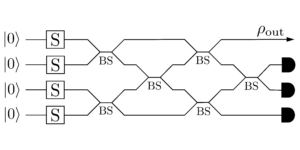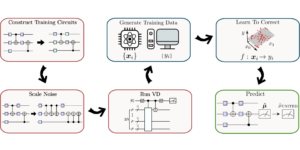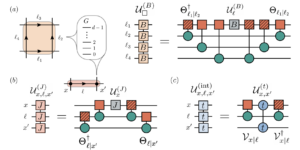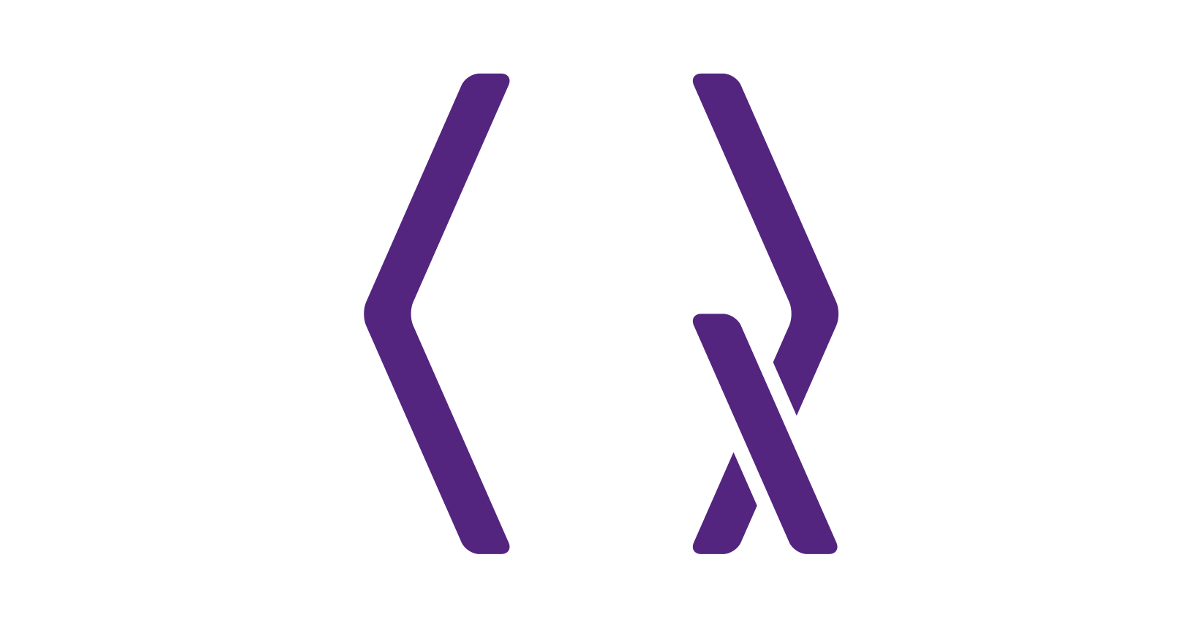
1HQS Quantum Simulations GmbH, Rintheimer Straße 23, 76131 Karlsruhe, Germany
2Dahlem Center for Complex Quantum Systems, Freie Universität Berlin, 14195 Berlin, Germany
3Helmholtz-Zentrum Berlin für Materialien und Energie, 14109 Berlin, Germany
Find this paper interesting or want to discuss? Scite or leave a comment on SciRate.
Abstract
A common approach to studying the performance of quantum error correcting codes is to assume independent and identically distributed single-qubit errors. However, the available experimental data shows that realistic errors in modern multi-qubit devices are typically neither independent nor identical across qubits. In this work, we develop and investigate the properties of topological surface codes adapted to a known noise structure by Clifford conjugations. We show that the surface code locally tailored to non-uniform single-qubit noise in conjunction with a scalable matching decoder yields an increase in error thresholds and exponential suppression of sub-threshold failure rates when compared to the standard surface code. Furthermore, we study the behaviour of the tailored surface code under local two-qubit noise and show the role that code degeneracy plays in correcting such noise. The proposed methods do not require additional overhead in terms of the number of qubits or gates and use a standard matching decoder, hence come at no extra cost compared to the standard surface-code error correction.
Popular summary
► BibTeX data
► References
[1] A. Y. Kitaev, Ann. Phys. 303, 2 (2003).
https://doi.org/10.1016/S0003-4916(02)00018-0
[2] E. Dennis, A. Kitaev, A. Landahl, and J. Preskill, J. Math. Phys. 43, 4452 (2002a).
https://doi.org/10.1063/1.1499754
[3] A. G. Fowler, A. C. Whiteside, and L. C. L. Hollenberg, Phys. Rev. Lett. 108, 180501 (2012a).
https://doi.org/10.1103/PhysRevLett.108.180501
[4] A. G. Fowler, M. Mariantoni, J. M. Martinis, and A. N. Cleland, Phys. Rev. A 86, 032324 (2012b).
https://doi.org/10.1103/PhysRevA.86.032324
[5] H. Bombin and M. A. Martin-Delgado, Phys. Rev. Lett. 97, 180501 (2006).
https://doi.org/10.1103/PhysRevLett.97.180501
[6] A. J. Landahl, J. T. Anderson, and P. R. Rice, Fault-tolerant quantum computing with color codes (2011), arXiv:1108.5738.
https://doi.org/10.48550/arXiv.1108.5738
arXiv:1108.5738
[7] A. M. Kubica, The ABCs of the color code: A study of topological quantum codes as toy models for fault-tolerant quantum computation and quantum phases of matter, Ph.D. thesis, California Institute of Technology (2018).
https://doi.org/10.7907/059V-MG69
[8] H. Bombín, New J. Phys. 17, 083002 (2015).
https://doi.org/10.1088/1367-2630/17/8/083002
[9] M. A. Nielsen and I. L. Chuang, Quantum Computation and Quantum Information: 10th Anniversary Edition (Cambridge University Press, 2011).
[10] E. Knill, R. Laflamme, and W. H. Zurek, Science 279, 342 (1998).
https://doi.org/10.1126/science.279.5349.342
[11] J. P. Bonilla Ataides, D. K. Tuckett, S. D. Bartlett, S. T. Flammia, and B. J. Brown, Nature Comm. 12, 2172 (2021).
https://doi.org/10.1038/s41467-021-22274-1
[12] G. Duclos-Cianci and D. Poulin, Phys. Rev. Lett. 104, 050504 (2010).
https://doi.org/10.1103/PhysRevLett.104.050504
[13] B. Criger and I. Ashraf, Quantum 2, 102 (2018).
https://doi.org/10.22331/q-2018-10-19-102
[14] R. Acharya et al., Nature 614, 676 (2023).
https://doi.org/10.1038/s41586-022-05434-1
[15] K. J. Satzinger et al., Science 374, 1237 (2021).
https://doi.org/10.1126/science.abi8378
[16] D. Nigg, M. Müller, E. A. Martinez, P. Schindler, M. Hennrich, T. Monz, M. A. Martin-Delgado, and R. Blatt, Science 345, 302 (2014).
https://doi.org/10.1126/science.1253742
[17] S. Krinner, N. Lacroix, A. Remm, A. D. Paolo, E. Genois, C. Leroux, C. Hellings, S. Lazar, F. Swiadek, J. Herrmann, G. J. Norris, C. K. Andersen, M. Müller, A. Blais, C. Eichler, and A. Wallraff, Nature 605, 669–674 (2022).
https://doi.org/10.1038/s41586-022-04566-8
[18] C. Ryan-Anderson, J. G. Bohnet, K. Lee, D. Gresh, A. Hankin, J. P. Gaebler, D. Francois, A. Chernoguzov, D. Lucchetti, N. C. Brown, T. M. Gatterman, S. K. Halit, K. Gilmore, J. Gerber, B. Neyenhuis, D. Hayes, and R. P. Stutz, Realization of real-time fault-tolerant quantum error correction (2021), arXiv:2107.07505 [quant-ph].
https://doi.org/10.48550/arXiv.2107.07505
arXiv:2107.07505
[19] A. Acín, I. Bloch, H. Buhrman, T. Calarco, C. Eichler, J. Eisert, J. Esteve, N. Gisin, S. J. Glaser, F. Jelezko, S. Kuhr, M. Lewenstein, M. F. Riedel, P. O. Schmidt, R. Thew, A. Wallraff, I. Walmsley, and F. K. Wilhelm, New J. Phys. 20, 080201 (2018).
https://doi.org/10.1088/1367-2630/aad1ea
[20] A. Dua, A. Kubica, L. Jiang, S. T. Flammia, and M. J. Gullans, Clifford-deformed surface codes (2022), arXiv:2201.07802.
https://doi.org/10.48550/arXiv.2201.07802
arXiv:2201.07802
[21] K. Tiurev, A. Pesah, P.-J. H. S. Derks, J. Roffe, J. Eisert, M. S. Kesselring, and J.-M. Reiner, The domain wall color code (2023), arXiv:2307.00054 [quant-ph].
https://doi.org/10.48550/arXiv.2307.00054
arXiv:2307.00054
[22] D. K. Tuckett, S. D. Bartlett, and S. T. Flammia, Phys. Rev. Lett. 120, 050505 (2018).
https://doi.org/10.1103/PhysRevLett.120.050505
[23] O. Higgott, T. C. Bohdanowicz, A. Kubica, S. T. Flammia, and E. T. Campbell, Improved decoding of circuit noise and fragile boundaries of tailored surface codes (2023), arXiv:2203.04948 [quant-ph].
https://doi.org/10.48550/arXiv.2203.04948
arXiv:2203.04948
[24] D. K. Tuckett, S. D. Bartlett, S. T. Flammia, and B. J. Brown, Phys. Rev. Lett. 124, 130501 (2020).
https://doi.org/10.1103/PhysRevLett.124.130501
[25] B. Srivastava, A. Frisk Kockum, and M. Granath, Quantum 6, 698 (2022).
https://doi.org/10.22331/q-2022-04-27-698
[26] J. F. S. Miguel, D. J. Williamson, and B. J. Brown, Quantum 7, 940 (2023).
https://doi.org/10.22331/q-2023-03-09-940
[27] J. Lee, J. Park, and J. Heo, Quantum Information Processing 20, 231 (2021).
https://doi.org/10.1007/s11128-021-03130-z
[28] D. K. Tuckett, A. S. Darmawan, C. T. Chubb, S. Bravyi, S. D. Bartlett, and S. T. Flammia, Phys. Rev. X 9, 041031 (2019).
https://doi.org/10.1103/PhysRevX.9.041031
[29] A. S. Darmawan, B. J. Brown, A. L. Grimsmo, D. K. Tuckett, and S. Puri, PRX Quantum 2, 030345 (2021).
https://doi.org/10.1103/PRXQuantum.2.030345
[30] IbmBrooklyn, IBM Quantum, https://quantumcomputing.ibm.com/services/.
https://quantumcomputing.ibm.com/services/
[31] IbmWashington, IBM Quantum, https://quantumcomputing.ibm.com/services/.
https://quantumcomputing.ibm.com/services/
[32] Aspen-M-2, Rigetti Computing, https://qcs.rigetti.com/qpus.
https://qcs.rigetti.com/qpus
[33] A. d. iOlius, J. E. Martinez, P. Fuentes, P. M. Crespo, and J. Garcia-Frias, Phys. Rev. A 106, 062428 (2022).
https://doi.org/10.1103/PhysRevA.106.062428
[34] A. d. iOlius, J. E. Martinez, P. Fuentes, and P. M. Crespo, Phys. Rev. A 108, 022401 (2023).
https://doi.org/10.1103/PhysRevA.108.022401
[35] Y. Wu et al., Phys. Rev. Lett. 127, 180501 (2021).
https://doi.org/10.1103/PhysRevLett.127.180501
[36] R. Harper and S. T. Flammia, Learning correlated noise in a 39-qubit quantum processor (2023), arXiv:2303.00780 [quant-ph].
https://doi.org/10.48550/arXiv.2303.00780
arXiv:2303.00780
[37] J. O’Gorman, N. H. Nickerson, P. Ross, J. J. Morton, and S. C. Benjamin, npj Quant. Inf. 2, 15019 (2016).
https://doi.org/10.1038/npjqi.2015.19
[38] A. Mizel and D. A. Lidar, Phys. Rev. B 70, 115310 (2004).
https://doi.org/10.1103/PhysRevB.70.115310
[39] T.-Q. Cai, X.-Y. Han, Y.-K. Wu, Y.-L. Ma, J.-H. Wang, Z.-L. Wang, H.-Y. Zhang, H.-Y. Wang, Y.-P. Song, and L.-M. Duan, Phys. Rev. Lett. 127, 060505 (2021).
https://doi.org/10.1103/PhysRevLett.127.060505
[40] P. Mundada, G. Zhang, T. Hazard, and A. Houck, Phys. Rev. Appl. 12, 054023 (2019).
https://doi.org/10.1103/PhysRevApplied.12.054023
[41] X. Xue, M. Russ, N. Samkharadze, B. Undseth, A. Sammak, G. Scappucci, and L. M. K. Vandersypen, Nature 601, 343 (2022).
https://doi.org/10.1038/s41586-021-04273-w
[42] D. M. Debroy, M. Li, S. Huang, and K. R. Brown, Logical performance of 9 qubit compass codes in ion traps with crosstalk errors (2020), arXiv:1910.08495 [quant-ph].
https://doi.org/10.48550/arXiv.1910.08495
arXiv:1910.08495
[43] A. Hutter and D. Loss, Phys. Rev. A 89, 042334 (2014).
https://doi.org/10.1103/PhysRevA.89.042334
[44] P. Baireuther, T. E. O’Brien, B. Tarasinski, and C. W. J. Beenakker, Quantum 2, 48 (2018).
https://doi.org/10.22331/q-2018-01-29-48
[45] J. P. Clemens, S. Siddiqui, and J. Gea-Banacloche, Phys. Rev. A 69, 062313 (2004).
https://doi.org/10.1103/PhysRevA.69.062313
[46] D. Aharonov, A. Kitaev, and J. Preskill, Phys. Rev. Lett. 96, 050504 (2006).
https://doi.org/10.1103/PhysRevLett.96.050504
[47] A. G. Fowler and J. M. Martinis, Phys. Rev. A 89, 032316 (2014).
https://doi.org/10.1103/PhysRevA.89.032316
[48] P. Jouzdani, E. Novais, I. S. Tupitsyn, and E. R. Mucciolo, Phys. Rev. A 90, 042315 (2014).
https://doi.org/10.1103/PhysRevA.90.042315
[49] J. E. Martinez, P. Fuentes, A. deMarti iOlius, J. Garcia-Frías, J. R. Fonollosa, and P. M. Crespo, Multi-qubit time-varying quantum channels for nisq-era superconducting quantum processors (2022), arXiv:2207.06838 [quant-ph].
https://doi.org/10.48550/arXiv.2207.06838
arXiv:2207.06838
[50] M. Li, D. Miller, M. Newman, Y. Wu, and K. R. Brown, Phys. Rev. X 9, 021041 (2019).
https://doi.org/10.1103/PhysRevX.9.021041
[51] J. Edmonds, Canadian Journal of Mathematics 17, 449–467 (1965).
https://doi.org/10.4153/CJM-1965-045-4
[52] G. Smith and J. A. Smolin, Phys. Rev. Lett. 98, 030501 (2007).
https://doi.org/10.1103/PhysRevLett.98.030501
[53] E. Dennis, A. Kitaev, A. Landahl, and J. Preskill, Journal of Mathematical Physics 43, 4452 (2002b).
https://doi.org/10.1063/1.1499754
[54] V. Kolmogorov, Mathematical Programming Computation 1, 43 (2009).
https://doi.org/10.1007/s12532-009-0002-8
[55] N. Delfosse and J.-P. Tillich, in 2014 IEEE International Symposium on Information Theory (2014) pp. 1071–1075.
https://doi.org/10.1109/ISIT.2014.6874997
[56] L. Skoric, D. E. Browne, K. M. Barnes, N. I. Gillespie, and E. T. Campbell, Parallel window decoding enables scalable fault tolerant quantum computation (2023), arXiv:2209.08552 [quant-ph].
https://doi.org/10.48550/arXiv.2209.08552
arXiv:2209.08552
[57] S. Bravyi, M. Suchara, and A. Vargo, Phys. Rev. A 90, 032326 (2014).
https://doi.org/10.1103/PhysRevA.90.032326
[58] For coherent noise, one could also consider more general Clifford conjugations, either by other unitaries from $C_1/U(1)$, or by conjugating several qubits at once and considering $C_n/U(1)$ for $ngeq 1$. Such code deformations will not be considered here.
[59] Such an XXZZ code is reminiscent of the rotated XZZX code introduced in Ref. [11] that has the same structure of logical operators as in our XXZZ code and therefore also performs optimally on a squared rotated lattice.
[60] S. S. Tannu and M. K. Qureshi, in Proceedings of the Twenty-Fourth International Conference on Architectural Support for Programming Languages and Operating Systems, ASPLOS ’19 (Association for Computing Machinery, New York, NY, USA, 2019) p. 987–999.
https://doi.org/10.1145/3297858.3304007
[61] J. Golden, A. Bärtschi, D. O’Malley, and S. Eidenbenz, ACM Trans. Quant. Comp. 3, 10.1145/3510857 (2022).
https://doi.org/10.1145/3510857
[62] F. Arute et al., Nature 574, 505 (2019).
https://doi.org/10.1038/s41586-019-1666-5
[63] F. Arute et al., Observation of separated dynamics of charge and spin in the Fermi-Hubbard model (2020), arXiv:2010.07965.
https://doi.org/10.48550/ARXIV.2010.07965
arXiv:2010.07965
[64] D. K. Tuckett, Tailoring surface codes: Improvements in quantum error correction with biased noise, Ph.D. thesis, University of Sydney (2020), (qecsim: https://github.com/qecsim/qecsim).
https://github.com/qecsim/qecsim
[65] O. Higgott, ACM Transactions on Quantum Computing 3, 10.1145/3505637 (2022).
https://doi.org/10.1145/3505637
[66] H. Bombin and M. A. Martin-Delgado, Phys. Rev. A 76, 012305 (2007).
https://doi.org/10.1103/PhysRevA.76.012305
[67] J. M. Chow, A. D. Córcoles, J. M. Gambetta, C. Rigetti, B. R. Johnson, J. A. Smolin, J. R. Rozen, G. A. Keefe, M. B. Rothwell, M. B. Ketchen, and M. Steffen, Phys. Rev. Lett. 107, 080502 (2011).
https://doi.org/10.1103/PhysRevLett.107.080502
[68] C. Rigetti and M. Devoret, Phys. Rev. B 81, 134507 (2010).
https://doi.org/10.1103/PhysRevB.81.134507
[69] L. Xie, J. Zhai, Z. Zhang, J. Allcock, S. Zhang, and Y.-C. Zheng, in Proceedings of the 27th ACM International Conference on Architectural Support for Programming Languages and Operating Systems, ASPLOS ’22 (Association for Computing Machinery, New York, NY, USA, 2022) p. 499–513.
https://doi.org/10.1145/3503222.3507761
[70] N. Grzesiak, R. Blümel, K. Wright, K. M. Beck, N. C. Pisenti, M. Li, V. Chaplin, J. M. Amini, S. Debnath, J.-S. Chen, and Y. Nam, Nature Communications 11, 2963 (2020).
https://doi.org/10.1038/s41467-020-16790-9
[71] In Eq. eqrefeq:weights_mod, we only include the zeroth order terms in $p_1$ and $p_2$. In Ref. PhysRevA.89.042334, the probability of connecting two defects by a chain of single- and two-qubit errors has been calculated to the the higher order. That is, the authors have also included the possibility of creating connecting two defects with Manhattan distance $N$ by one single-qubit error and $N-1$ two-qubit errors when $p_1/p_2 ll 1$ (by one two-qubit error and $N-1$ single-qubit errors when $p_2/p_1 ll 1$). However, our simulations show that adding such higher-order terms has vahishingly small effect on the decoding fidelity.
[72] C. J. Trout, M. Li, M. Gutiérrez, Y. Wu, S.-T. Wang, L. Duan, and K. R. Brown, New Journal of Physics 20, 043038 (2018).
https://doi.org/10.1088/1367-2630/aab341
[73] S. Puri, L. St-Jean, J. A. Gross, A. Grimm, N. E. Frattini, P. S. Iyer, A. Krishna, S. Touzard, L. Jiang, A. Blais, S. T. Flammia, and S. M. Girvin, Science Advances 6, 10.1126/sciadv.aay5901 (2020).
https://doi.org/10.1126/sciadv.aay5901
[74] E. Huang, A. Pesah, C. T. Chubb, M. Vasmer, and A. Dua, Tailoring three-dimensional topological codes for biased noise (2022), arXiv:2211.02116 [quant-ph].
https://doi.org/10.48550/arXiv.2211.02116
arXiv:2211.02116
[75] J. Roffe, L. Z. Cohen, A. O. Quintavalle, D. Chandra, and E. T. Campbell, Quantum 7, 1005 (2023).
https://doi.org/10.22331/q-2023-05-15-1005
[76] L. Bennett, B. Melchers, and B. Proppe, Curta: A general-purpose high-performance computer at ZEDAT, Freie Universität Berlin (2020).
https://doi.org/10.17169/refubium-26754
[77] The codes used for numerical simulations of the QECCs studied in this work are available at https://github.com/HQSquantumsimulations/non-iid-error-correction-published.
https://github.com/HQSquantumsimulations/non-iid-error-correction-published
[78] The data obtained from numerical simulations and used for the plots in this work is available at https://github.com/peter-janderks/plots-and-data-non-iid-errors-with-surface-codes/.
https://github.com/peter-janderks/plots-and-data-non-iid-errors-with-surface-codes/
[79] C. Wang, J. Harrington, and J. Preskill, Ann. Phys. 303, 31 (2003).
https://doi.org/10.1016/S0003-4916(02)00019-2
[80] J. W. Harrington, Analysis of quantum error-correcting codes: symplectic lattice codes and toric codes, Ph.D. thesis, California Institute of Technology (2004).
[81] R. Sweke, P. Boes, N. H. Y. Ng, C. Sparaciari, J. Eisert, and M. Goihl, Commun. Phys. 5, 150 (2022).
https://doi.org/10.1038/s42005-022-00930-2
Cited by
[1] Josu Etxezarreta Martinez, Patricio Fuentes, Antonio deMarti iOlius, Javier Garcia-Frias, Javier Rodríguez Fonollosa, and Pedro M. Crespo, “Multiqubit time-varying quantum channels for NISQ-era superconducting quantum processors”, Physical Review Research 5 3, 033055 (2023).
[2] Moritz Lange, Pontus Havström, Basudha Srivastava, Valdemar Bergentall, Karl Hammar, Olivia Heuts, Evert van Nieuwenburg, and Mats Granath, “Data-driven decoding of quantum error correcting codes using graph neural networks”, arXiv:2307.01241, (2023).
[3] Joschka Roffe, Lawrence Z. Cohen, Armanda O. Quintavalle, Daryus Chandra, and Earl T. Campbell, “Bias-tailored quantum LDPC codes”, Quantum 7, 1005 (2023).
[4] Eric Huang, Arthur Pesah, Christopher T. Chubb, Michael Vasmer, and Arpit Dua, “Tailoring three-dimensional topological codes for biased noise”, arXiv:2211.02116, (2022).
[5] Konstantin Tiurev, Arthur Pesah, Peter-Jan H. S. Derks, Joschka Roffe, Jens Eisert, Markus S. Kesselring, and Jan-Michael Reiner, “The domain wall color code”, arXiv:2307.00054, (2023).
[6] Yue Ma, Michael Hanks, and M. S. Kim, “Non-Pauli errors can be efficiently sampled in qudit surface codes”, arXiv:2303.16837, (2023).
The above citations are from SAO/NASA ADS (last updated successfully 2023-09-27 02:18:23). The list may be incomplete as not all publishers provide suitable and complete citation data.
On Crossref’s cited-by service no data on citing works was found (last attempt 2023-09-27 02:18:22).
This Paper is published in Quantum under the Creative Commons Attribution 4.0 International (CC BY 4.0) license. Copyright remains with the original copyright holders such as the authors or their institutions.
- SEO Powered Content & PR Distribution. Get Amplified Today.
- PlatoData.Network Vertical Generative Ai. Empower Yourself. Access Here.
- PlatoAiStream. Web3 Intelligence. Knowledge Amplified. Access Here.
- PlatoESG. Carbon, CleanTech, Energy, Environment, Solar, Waste Management. Access Here.
- PlatoHealth. Biotech and Clinical Trials Intelligence. Access Here.
- Source: https://quantum-journal.org/papers/q-2023-09-26-1123/
- :has
- :is
- :not
- ][p
- 1
- 10
- 10th
- 11
- 12
- 13
- 14
- 15%
- 150
- 16
- 17
- 19
- 1998
- 20
- 2006
- 2011
- 2014
- 2015
- 2016
- 2018
- 2019
- 2020
- 2021
- 2022
- 2023
- 22
- 23
- 24
- 25
- 26%
- 27
- 27th
- 28
- 29
- 30
- 31
- 32
- 33
- 36
- 39
- 40
- 41
- 49
- 50
- 51
- 54
- 60
- 66
- 67
- 7
- 70
- 72
- 75
- 77
- 8
- 80
- 9
- 97
- 98
- a
- above
- ABSTRACT
- access
- ACM
- across
- adding
- Additional
- advances
- affiliations
- AL
- All
- allows
- also
- an
- analysis
- and
- anderson
- Anniversary
- approach
- architectural
- ARE
- arpit
- Arthur
- AS
- Ashraf
- Association
- assume
- At
- attempt
- author
- authors
- available
- BE
- been
- Benjamin
- Berlin
- BEST
- biased
- boundaries
- Break
- brown
- but
- by
- calculated
- california
- cambridge
- CAN
- Canadian
- Center
- chain
- channels
- charge
- chen
- chow
- Christopher
- Chubb
- code
- codes
- cohen
- COHERENT
- color
- come
- comm
- comment
- Common
- Commons
- Communications
- COMP
- compared
- Compass
- complete
- complex
- computation
- computer
- computing
- Conference
- conjunction
- Connecting
- Consider
- considered
- considering
- copyright
- correct
- Cost
- could
- Creating
- data
- data-driven
- Decoding
- develop
- Devices
- discuss
- distance
- distributed
- do
- domain
- dynamics
- e
- E&T
- edition
- effect
- efficiently
- either
- enables
- error
- Errors
- experimental
- exponential
- extra
- Failure
- fidelity
- For
- found
- from
- Furthermore
- Gates
- General
- general-purpose
- GmBH
- Golden
- good
- graph
- gross
- harvard
- Have
- hence
- here
- high-performance
- higher
- holders
- However
- HTTPS
- huang
- i
- IBM
- ibm quantum
- identical
- IEEE
- improved
- improvements
- in
- include
- included
- Increase
- independent
- information
- Institute
- institutions
- interesting
- International
- introduced
- investigate
- JavaScript
- Johnson
- journal
- karl
- Kim
- known
- Languages
- Last
- lawrence
- leading
- learning
- Leave
- Lee
- Li
- License
- List
- ll
- local
- locally
- logical
- loss
- machinery
- make
- matching
- math
- mathematical
- mathematics
- Matter
- May..
- methods
- Michael
- Miller
- model
- models
- Modern
- Month
- more
- Nam
- Nature
- Neither
- networks
- neural
- neural networks
- New
- New York
- no
- Noise
- number
- NY
- obtained
- of
- on
- once
- ONE
- only
- open
- operating
- operating systems
- operators
- or
- order
- original
- Other
- our
- pages
- Paolo
- Paper
- Parallel
- Park
- performance
- performs
- Phases of Matter
- Physics
- plato
- Plato Data Intelligence
- PlatoData
- plays
- possibility
- press
- Proceedings
- processing
- Processor
- processors
- Programming
- programming languages
- properties
- proposed
- provide
- published
- publisher
- publishers
- Quant
- Quantum
- quantum computing
- quantum error correction
- quantum information
- quantum systems
- Qubit
- qubits
- R
- Rates
- real-time
- realistic
- realization
- references
- remains
- reminiscent
- require
- research
- review
- Rice
- roadmap
- Role
- s
- same
- scalable
- Science
- several
- show
- Shows
- small
- song
- Spin
- Squared
- standard
- structure
- studied
- Study
- Studying
- Successfully
- such
- suitable
- superconducting
- support
- suppression
- Surface
- sydney
- Symposium
- Systems
- tailored
- Technology
- terms
- that
- The
- their
- theory
- therefore
- These
- thesis
- this
- three-dimensional
- Title
- to
- topological quantum
- Transactions
- traps
- two
- typically
- under
- university
- University of Sydney
- updated
- URL
- USA
- use
- used
- using
- volume
- W
- Wall
- want
- was
- we
- when
- will
- window
- with
- Work
- works
- Wright
- wu
- X
- year
- yields
- york
- zephyrnet



